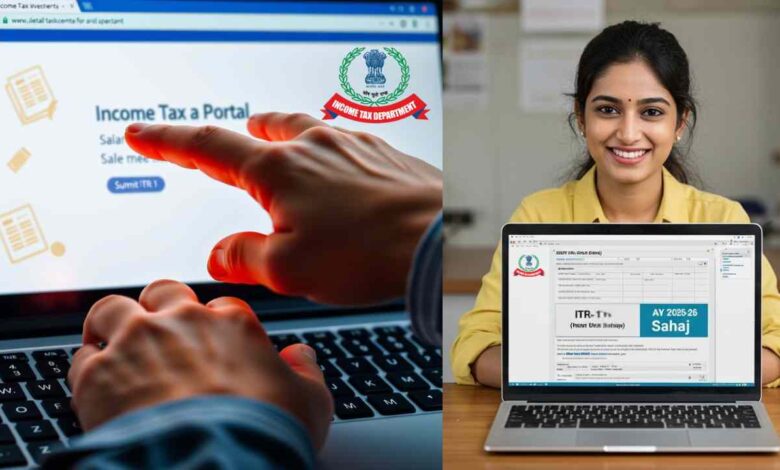ITR-1 Sahaj for AY 2025-26: Your Complete Guide to Easy Tax Filing & Key Updates

The income tax return (ITR) filing season for Assessment Year (AY) 2025-26 (Financial Year 2024-25) is underway! The Income Tax Department has released the Excel Utility for ITR-1 (Sahaj) on May 30, 2025. If you’re a salaried individual or have straightforward income sources, ITR-1 could be the simplest way to file your taxes. This guide breaks down everything you need to know about ITR-1 for AY 2025-26, including crucial new updates.
What is ITR-1 (Sahaj)?
ITR-1, also known as ‘Sahaj,’ is a simplified income tax return form designed for resident individuals in India. Its primary purpose is to make tax filing easier for those with a total income of up to ₹50 lakh from specific, uncomplicated sources. Think of it as the most basic ITR form for eligible taxpayers.
Who Can File ITR-1 for AY 2025-26 (FY 2024-25)?
To be eligible to file your income tax return using ITR-1 for AY 2025-26, you must meet the following conditions:
- You must be a Resident Individual.
- Your total income must not exceed ₹50 lakh during the financial year.
- Your income sources should be limited to:
- Income from Salary/Pension: This includes income from one or multiple employers.
- Income from One House Property: Excluding cases where losses are brought forward from previous years or losses to be carried forward.
- Income from Other Sources: This typically covers interest from savings accounts, fixed deposits, family pension, etc. (It does not include winnings from lotteries or horse races).
- Agricultural Income: Up to ₹5,000.
- New! Specific Long-Term Capital Gains (LTCG): In a significant update for AY 2025-26, you can now use ITR-1 if you have LTCG under Section 112A (from listed equity shares and equity-oriented mutual funds) up to ₹1.25 lakh. This is applicable only if there’s no tax due on this LTCG and no capital losses (brought forward or to be carried forward). This change is a big relief for small investors.
- If income of a spouse or minor child is clubbed with your income, their income must also fall within the above-mentioned ITR-1 eligibility criteria.
Crucial Reminder: Linking your Aadhaar card with your PAN is mandatory for filing your income tax return.
Get Instant News Updates!
Join on TelegramWho Cannot File ITR-1 for AY 2025-26?
You are not eligible to use ITR-1 if any of the following apply to you:
- Your total income exceeds ₹50 lakh.
- You are a Director in any company.
- You have held unlisted equity shares at any time during the financial year.
- You are a Resident Not Ordinarily Resident (RNOR) or a Non-Resident Indian (NRI).
- You have income from more than one house property.
- You have income from lotteries, racehorses, or legal gambling.
- You have taxable capital gains (short-term or long-term) other than the specific LTCG (up to ₹1.25 lakh under Sec 112A) mentioned above.
- You have income from Virtual Digital Assets (like cryptocurrency).
- Your agricultural income exceeds ₹5,000.
- You have income from business or profession.
- You have any assets (including financial interest in any entity) located outside India or signing authority in any account located outside India.
- You are claiming relief for foreign tax paid or double taxation relief under sections 90/90A/91.
- You have deferred income tax on Employee Stock Option Plans (ESOPs) received from an eligible start-up.
- Tax has been deducted (TDS) under Section 194N (on cash withdrawals exceeding limits).
Major Changes in ITR-1 Form for AY 2025-26
The ITR-1 form for AY 2025-26 comes with a few important updates that taxpayers should be aware of:
- Inclusion of Specific LTCG Reporting: As highlighted earlier, taxpayers can now report LTCG under Section 112A (up to ₹1.25 lakh, with no tax due and no b/f or c/f capital losses) directly in ITR-1. This simplifies filing for many small investors who previously had to use ITR-2.
- Enhanced Disclosures for Deductions: When claiming deductions under Sections 80C to 80U, you will now need to select the specific clause/sub-section from a drop-down menu in the e-filing portal. This change aims to improve accuracy and transparency in reporting deductions. Additionally, new fields have been introduced for reporting income from retirement benefit accounts maintained abroad (under Section 89A) for better relief tracking.
- Aadhaar Enrolment ID No Longer Accepted: The option to use the 28-digit Aadhaar Enrolment ID has been removed. You must provide your valid 12-digit Aadhaar Number for ITR filing.
- Additional Column in TDS Schedule: A new column has been added to ‘Schedule – TDS Details.’ This requires you to specify the particular section under which TDS was deducted, providing more clarity on tax credits.
Documents Needed to File ITR-1
While you don’t need to attach any documents with your ITR-1 form, it’s essential to have the following ready for accurate filing:
- Form 16: Issued by your employer(s) for the financial year.
- Form 26AS & Annual Information Statement (AIS): Download these from the income tax portal to verify TDS, TCS, and other tax-related information. Ensure the TDS details in Form 16 match those in Form 26AS.
- Receipts for Deductions/Exemptions: If you haven’t submitted proofs for certain deductions (like HRA, Section 80C, 80D investments) to your employer, keep these receipts handy to claim them directly in your return.
- PAN Card.
- Aadhaar Card.
- Bank Account Statements/Interest Certificates: For details of interest income from savings accounts, fixed deposits, etc.
How to File ITR-1 (Sahaj) Online for AY 2025-26
Filing ITR-1 online through the official income tax portal is a straightforward process:
- Visit the Income Tax e-filing portal:
incometax.gov.in. - Log in to your account using your User ID (PAN) and password. If you’re a new user, you’ll need to register first.
- Navigate to ‘e-File’ > ‘Income Tax Return’ > ‘File Income Tax Return’.
- Select the Assessment Year as ‘2025-26’ and the Mode of Filing as ‘Online’.
- Click on ‘Start New Filing’.
- Choose your applicable status as ‘Individual’ and click ‘Continue’.
- When prompted to select the ITR form, choose ‘ITR-1’.
- Click on ‘Let’s Get Started’.
- Select the reason(s) why you are filing the income tax return and proceed.
- You will then encounter different sections to fill:
- Personal Information: Verify your pre-filled details like name, PAN, Aadhaar, contact information, and bank account details. Ensure your primary bank account for refunds is selected.
- Gross Total Income: Enter details of your income from salary, one house property, and other sources. Much of this may be pre-filled.
- Total Deductions: Claim applicable deductions under Chapter VI-A (like 80C, 80D, 80TTA, etc.).
- Tax Paid: Review details of taxes already paid, including TDS, TCS, Advance Tax, and Self-Assessment Tax.
- Total Tax Liability: The portal will compute your tax liability based on the information provided. If tax is due, you’ll need to pay it. If excess tax has been paid, you’ll be eligible for a refund.
- After filling all sections, preview your return. Double-check all figures and information.
- If everything is correct, proceed to validation. The system will highlight any errors.
- Once validated, submit your return and then proceed to e-Verify it. You can e-verify using Aadhaar OTP, net banking, bank account EVC, or Demat account EVC. E-verification is mandatory to complete the filing process.
Filing your income tax return accurately and on time is a crucial responsibility. We hope this comprehensive guide helps you understand ITR-1 (Sahaj) for AY 2025-26 and navigate the filing process with ease.
Disclaimer: Tax laws are subject to change. Always refer to the official Income Tax Department website or consult with a qualified tax professional for the most current information and personalized advice.

